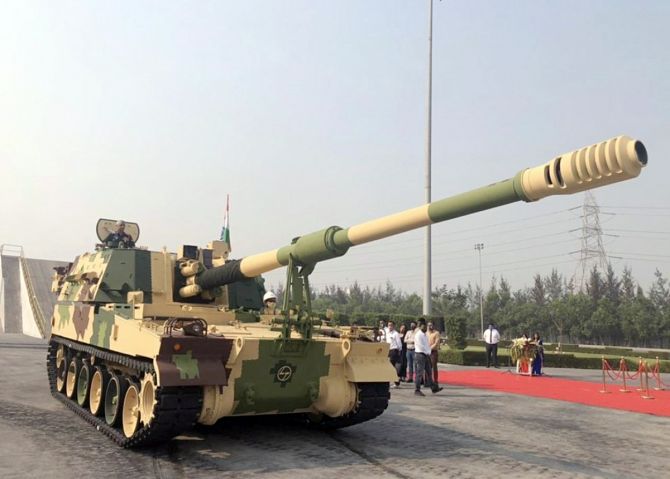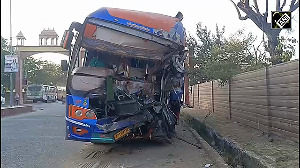India has over 4,000 medium tanks, but not a single light tank.
It remains to be seen whether the Ladakh face-off with China galvanises a change, observes Ajai Shukla.

A key acquisition decision that has emerged during the 20 month-long armed stand-off in Eastern Ladakh between the Indian and Chinese militaries is for the Indian Army to arm itself in high-altitude terrain with indigenously built light tanks.
As the tension mounted in May 2020, both the Indian Army and China's People's Liberation Army airlifted main battle tanks to the Line of Actual Control between the two militaries to bolster their combat muscles.
However, the advantage rested with the PLA, whose armoured units in Tibet are equipped with the new ZTQ-15 (or Type 15) light tank.
While the Indian armoured units laboured to move their heavy and underpowered, 42-tonne, Russian-origin T-72 MBTs across mountain passes as high as 17,500 feet, China's 33-tonne ZTQ-15 light tanks (36 tonnes with additional slap-on armour) were able to move through the 14,000 feet valleys with far greater ease.
With their 1,000 horsepower Norinco engines, the ZTQ-15 tanks, also called the Black Panther, offered a power-to-weight ratio of more than 30 HP per tonne -- enough to move tanks in that oxygen-depleted altitude.
In contrast, India's 42-tonne T-72s, with their 780 HP power packs, offer an inadequate power-to-weight ratio of just 18.5 HP per tonne. The T-72s are also significantly larger than the ZTQ-15, hindering their mobility over small bridges and narrow roads.
Given these operational disadvantages, Indian tank warfare planners have long discussed the need for a smaller, lighter tank for high-altitude warfare. This discussion gathered traction in 2017, when a heavy Chinese build-up in Doklam, Sikkim, needed to be countered. The PLA's entry into Eastern Ladakh in 2020-2021 galvanised the debate again.
Light tanks offer utility not just on the high-altitude India-China border, but on the mountain border with Pakistan in Jammu and Kashmir as well. They can also be used for counter-insurgency tasks in jungle and urban terrain.
Airlifting T-72s and T-90s is impossible from high altitude, 10,700 feet-high airfields such as Leh, but 25-30-tonne light tanks can be transported by the Indian Air Force's strategic airlifters -- namely the Ilyushin-76 and C-17 Globemaster III. Light tanks also lend themselves more easily to amphibious warfare.
With the Aatmanirbhar Bharat (self-reliant India) motto guiding procurement and having built up experience on the Arjun tank project, the Combat Vehicles Research and Development Establishment -- a Chennai-based laboratory of the Defence R&D Organisation -- was given the task.
It was calculated that Indian troops on the 3,488-km India-China border would need about 350-500 light tanks. There were already two T-72 armoured regiments (each with 45 tanks) defending the LAC.
Over the years, the army had additionally raised two independent armoured brigades -- one in Ladakh and the other in Sikkim and Arunachal Pradesh. Each of these brigades would field 175-200 light tanks.
Charged with building a 25-tonne, indigenous, light tank quickly, Indian planners presented two options. Both were based on customising the proven 28-tonne, chassis, hull and engine of the K-9 Vajra -- a heavy, tracked artillery gun that Larsen & Toubro has manufactured near Pune for the artillery with technology transfer from South Korea's Hanwha Defense.
Both options involved putting a smaller, lighter turret in place of the K-9 Vajra's heavy, 155 mm artillery gun that shoots over-the-horizon to over 40 km.
One option involved fitting the light tank with a T-90 turret that mounts a heavy 125 mm tank gun. However, the 8-9 tonne T-90 tank turret, mounted on the 28-tonne chassis, would take the weight of the light tank to an unacceptable 36-37 tonnes.
The second option involved replacing the K-9 Vajra’s artillery turret with a smaller turret that is fitted with a direct firing, high-pressure, 105 mm gun. This turret would be procured, ready-built, from Belgian firm John Cockerill.
These options, however, took a back seat as the army fell back on its time-tested solution of buying Russian tanks.
An Indian Army team inspected the 2S25 Sprut Russian armoured vehicle, but it soon became clear that the Sprut was not even a tank; it was a less mobile, anti-tank weapon, termed a 'tank destroyer'. Even the Russian army had shrunk from inducting the Sprut into operational service -- the Russian military bought only 24 Spruts.
Now Hanwha Defense, quick to see an opportunity, is preparing to offer the Indian Army its K21-105 light tank. This is a formidable platform, with a 105 mm turret that can achieve over 42 degrees of elevation -- useful for firing at targets on higher slopes -- and at a 10-degree depression angle.
However, the army, DRDO and L&T decided to pursue the project cooperatively, under the DRDO model of 'Development cum Production Partner' (DCPP). In April 2021, the army issued a Request for Information (RFI), mandating an overall tank weight of under 25 tonnes and a power-to-weight ratio of at least 25 HP/tonne.
According to the RFI, 'The light tank must have the versatility to execute operations in varying terrain conditions across diverse threats and equipment profile of the adversaries.'
A DCPP agreement involves a firm that does the development work, while DRDO provides advice, formulates specifications, contributes in design reviews and provides access to test facilities.
The DCPP model was formalised in the modified version of DRDO's 'Policy and Procedures for Transfer of Technology', dated October 2019. Most development programmes are now being issued under this, so that the developed product is ready for production immediately after trials are concluded.
The cost of development, which DRDO incurs in such projects, is not cheap. Nor is the cost negligible for the development partner, in this case L&T, which ends up paying for years of committing the talent and the team.
India has used light tanks in practically every operation since Independence.
Stuarts and Sherman tanks were used in the Battle of Kohima in 1944.
In 1948, these tanks were critical in pushing back Pakistani forces in Zojila.
In 1962, French AMX-13 tanks were used in the battle at Gurung Hill and also deployed in Bomdila and Dirang.
In 1971, AMX-13 and PT-76 tanks turned the tables on Pakistan in the Battle of Garibpur in then East Pakistan.
However, after the AMX 13 and PT-76 tanks were phased out, no replacements were inducted. The army's focus remained on building armour superiority on the Pakistan border and matching Pakistan, tank for tank, which required medium and heavy tanks.
Today, India has over 4,000 medium tanks, but not a single light tank. It remains to be seen whether the Ladakh face-off with China galvanises a change.











